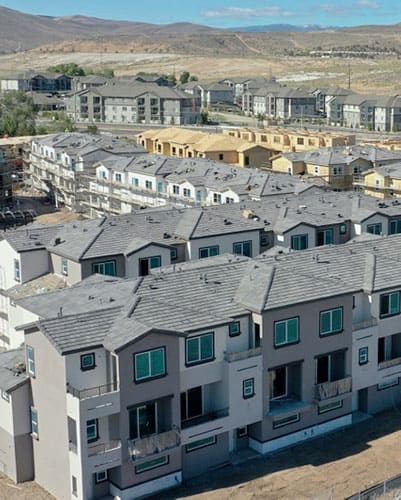Introducing, the industry’s most powerful tool for lowering costs.
The 1085 Group specializes in construction efficiency.
The 1085 Group works closely with clients to develop exclusive products that are rich with amenities but significantly more affordable to build and more affordable rent.
Products from the 1085 Group, a collective of independent design professionals, use an inclusive, next-generation process that relies on rigorous design and engineering that provides for a more efficient, streamlined approach to construction.
It’s a “top down, bottom up” approach that removes variables and redundancies while maximizing the use of “smart labor,” uniform materials, tools and techniques, and off-site manufacturing.
The typical approach to cutting costs is to “grind” subcontractors and material suppliers. GCs often use pressure and leverage to force others to reduce their rates, without offering an alternative for profitability.
The 1085 Group allows clients and project associates to avoid the grind by creating an environment where profitability comes from increased efficiency.
The 1085 Group provides project partners with the process and the technology to eliminate waste and unnecessary markups, avoid time- and money-consuming disputes, and resolve scheduling conflicts.
Products are made more efficient by introducing as many repeatable processes as possible, not just within a project but across all Pacific West projects. Each time a worker repeats a process they become more proficient, and that proficiency increases exponentially with every additional project.
The FlexBuilding
A for-rent or for-sale, garden-style product that gives clients the ability to alter a building’s density without affecting the overall footprint.
MOREThe RowTown
A for-sale, vertical town-home product that’s possibly the most construction-efficient multi-family home ever designed.
MOREThe xSpace
A for-rent or for-sale product that converts garage and storage space into valuable livable space.
MOREThe eMax
A three-story apartment design featuring innovative “tuck under” parking that greatly increases livable density.
MOREThe UltraFlex
A multi-story townhome design that maximizes open living spaces while allowing for a significant increase in site density.
MOREE3 Flats
The inventive E3 design eliminates unused space and combines living areas to offer renters a simpler style of living.
MORELess expensive,
quicker to build,
superior quality.
Our revolutionary, multi-family products have been designed and engineered to allow for significant portions to be manufactured off-site.
Off-site manufacturing is not only more economical, it’s appreciably faster. Unlike on-site labor, off-site labor is allowed to work in continual shifts, 24 hours a day. Off-site manufacturing also allows us to start construction (on up to a third of a building) from day one. This cuts the overall build time by a month or more.
Off-site manufacturing improves quality. It’s free from environmental variables. Every step is easily managed and monitored. Because we use the same assemblies and manufacturing teams, we can eliminate virtually all errors through experience and repetition.
Off-site sections have even been designed to be transported on regular-sized vehicles. Eliminating oversized loads reduces costs and avoids delays associated with extra DOT requirements.
Building projects is risky.
Building a Project is gambling. It’s a high-risk approach for possibly slightly higher returns. It’s often based on a temporary market bubble, such as an artificial bump in a market’s economy. As history has shown, bubbles always burst.
We don’t believe in gambling, which is why we don’t build Projects.
Building products eliminates risk.
We’re committed to designing products with construction methods that are proven, repeatable, and scalable.
Those building projects need to estimate costs. We guarantee costs.
While building products offers immense benefits for “one off” developments, it’s true strength is realized when applied to multiple projects within the same regional market.
Bubbles burst.
Building projects is often based on an artificial or fragile economic bubble. Renter income and the market economy often appear healthier than they really are, prompting a developer to base rents on the bubble. If history has shown us anything, it’s that bubbles burst. Always. That’s the only true guarantee with project building.
Basing rents on an artificial bubble can even erode the very market conditions that attracted a developer. The allusion of a strong local economy makes it tempting for a developer to raise initial rents. Those inflated rents absorb expendable income at a higher rate, which can lead to an immediate economic downturn in a market that once seemed so promising. Sometimes, the downturn can happen even before a project reaches 100% percent occupancy.
Costs have never been more critical.
Recent statistics show that while the overall economy is rebounding, real-world wages haven’t kept pace with other sectors. Renter income can appear higher than it really is, and the market seems more flexible than it really is.
Maximizing profits by boosting pricing, or keeping rents unnecessarily high, is extremely risky. Tenants are starting to see apartments and multi-family homes as viable, long-term alternatives to detached housing. They demand the absolute most for their money.
Keeping rents reasonable nurtures a growing market, allowing developers and other project members to further their success by building multiple projects.
Building a project can actually erode the very market that initially attracted a developer. Higher-priced rents absorb expendable income at an artificially high rate, leading to an economic downturn in a regional market. Often, the downturn occurs even before a project reaches full occupancy, putting the project at risk and erasing future opportunities for additional apartment developments.
It’s clear, building projects instead of products just isn’t good business. Not for clients, not for customers, not for communities.





